2011/10/22~11/1
Report on field research tour of JICA/JICA [SATREPS] Kala-azar Project, 2011, Mymensingh
Kala-azar or visceral lieshmaniasis, a fatal but neglected disease becomes devastating every year. India, Bangladesh, Nepal is the highest endemic area in the world for Kala-azar. In Bangladesh the highest rates in the districts of Mymensingh, Pabna, and Tangail. In Mymensingh specifically, the average annual incidence rate between 1994 and 2004 was 5.8/10,000, and at 2007 as high as 300/10,000 in the most affected communities. (a, b)
Japan International Corporation Agency (JICA) and Japan Science and Technology Agency (JST) started the joint program, so called SATREPS, a five years long project under health sector "Research and development of prevention and diagnosis for tropical neglected diseases specially Kala-azar" collaborated with Bangladesh government's Kala-azar elimination program. On this purpose group of researchers and students came to Bangladesh in cooperation with ICDDR,B to study entomological nature of Kala-azar vector sand fly, which is the basis for analyzing the epidemic nature of disease in this area. Trishal upazilla of Mymensingh is chosen for their study area.
The tour was scheduled from 21st Oct to 2nd Nov, 2011.Two groups reached Dhaka at 21st Oct. In first group Prof Matsumoto accompanied with Prof Kobayashi, Dr. Emi Ogasawara and Mr. Ishii (from Dhaka) came here to survey SK hospital and field works outline. They were scheduled to go back to Japan at 27th Oct. Another group consists of Dr. Sanjoba, Dr. Yusuf, Dr. Niikura, Mr. Osada, Ms. Jiamei, Mr. Mehmet and me, Sohana. Mr. Abdus Salam, Health Inspector of Trishal Upazilla health complex accompanied us for providing us the information and the status of Kala-azar of that area and also informed us about the patient.
Both groups started their journey at 22nd Oct, 2011 at 8.00 am from Bengal Inn of Gulshan-1, Dhaka. After we reached Mymensingh we directly went to Trishal health complex to meet Mr. Salam and pick him up and started our work. Three villages of Mymensingh Alohori of Harirampur union, Magurjura of Mathbari union and Kakchar & Barma of Kanihari union was decided earlier for study. The work procedures were mainly setup light traps, animal bed trap and sticky paper trap to collect the sand fly and preserve them in alcohol. Another purpose was to set up the design & study the live sand fly for further field research tour for next time.
We set up the light trap (automatic & manual) and the animal bed trap at the evening before sunset around 4.30 to 5.00 pm. As sand flies are most active around sunrise and sunset, the light traps were left there overnight and were collected them after sunrise; approximately between 8.00 to 9.00 am. For our table work we used Trishal field office of icddr,b at Porabari Road. In field office the trapped sand flies were mainly separated from many other different kinds of insects specially mosquitoes and ten they were preserved in alcohol.
We set up the light trap (automatic & manual) and the animal bed trap at the evening before sunset around 4.30 to 5.00 pm. As sand flies are most active around sunrise and sunset, the light traps were left there overnight and were collected them after sunrise; approximately between 8.00 to 9.00 am. For our table work we used Trishal field office of icddr,b at Porabari Road. In field office the trapped sand flies were mainly separated from many other different kinds of insects specially mosquitoes and ten they were preserved in alcohol.
At 22nd Oct Dr. Alim, a researcher of Mymensingh Agricultural University met us in dinner. At 23rd Oct and 31st Oct meeting was held with Dr. Toha, senior medical officer of Kala-azar project, icddr,b. At 23rd Ms. Mori, Ms. Inaoka, Ms. Nakano of JOCV joined us and observed our field work at 24th Oct.
There is a brief outline of our tour below:
At Nov 3rd second group departed from Dhaka at 1.00 pm.
| Date | Activity |
| 22nd Oct | set up light trap at Alohori para of Alohori village |
| 23rd Oct | collect light trap from Alohori Set up light trap at Moddhopara of Magurjura village |
| 24th Oct | collect light trap from Magurjura Separation and preservation of samples was in field office |
| 25th Oct | set up animal bed trap with cow at Magurjura Collect live sand fly |
| 26th Oct | departure of first group from Mymensingh Collect animal bed trap and preservation of samples at field office Set up light trap at Magurjura |
| 27th Oct | collect light trap from Magurjura Preservation of samples in field office |
| 28th Oct | set sticky paper trap at Magurjura Set up light trap |
| 29th Oct | collect light trap Preservation of sample in field office Set up more sticky paper trap at Magurjura |
| 30th Oct | animal bed trap with goats at Magurjura Collect live sand fly |
| 31th Oct |
collect animal bed trap and preserve samples Collect all sticky paper trap Separation of sand fly from sticky paper trap Observe Kakchar & Barma village and set up light traps |
| 1st Nov | collect light traps from Kakchar & Barma Make list of all instruments and separated the tools & instrument as required |
| 2nd Nov | departure from Mymensingh Meeting at icddr,b ,Dhaka |
At Nov 3rd second group departed from Dhaka at 1.00 pm.
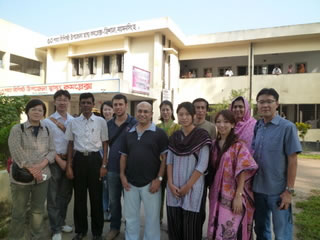
Pic 1: Group 1 & Group 2 in front of Trishal Health Complex; From left Prof Kobayashi, Dr. Niikura, health inspector Salam, Mr. Mehmet, Prof Yusuf And Prof Matsumoto behind second from right.
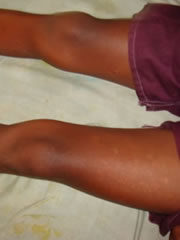
Pic 2: a PKDL patient at Trishal Health Complex. He was suffering from Kala-azar now results PKDL.
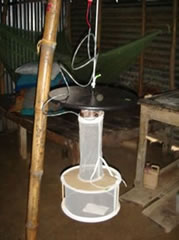
Pic 3: Light Trap
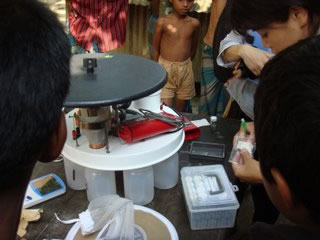
Pic 4: Dr. Sanjoba collecting insects from automatic light trap
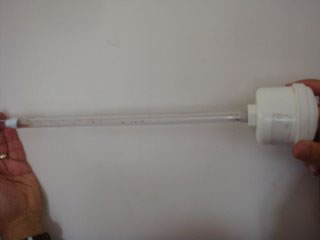
Pic 5: collected live sand flies
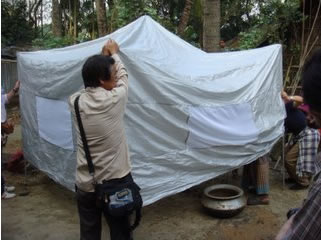
Pic 6: animal bed trap was made
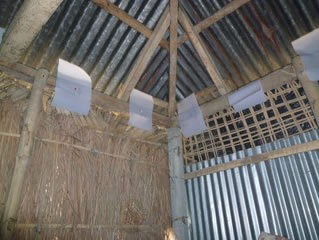
Pic 7: sticky paper trap
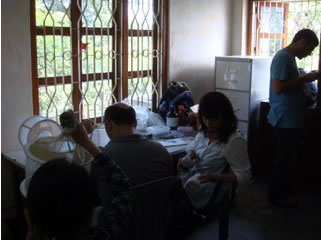
Pic 8: work at field office
References:
From icddr,b website:
a. Bern C and Chowdhury R. The epidemiology of Visceral Leishmaniasis in
Bangladesh: prospects for improved control. Indian J Med Res 2006; 123:275-88.
b. Data obtained from Fulbaria Upazilla Health Complex Medical Director (2007)
https://centre.icddrb.org/pub/publication.jsp?classificationID=56&pubID=9039
From icddr,b website:
a. Bern C and Chowdhury R. The epidemiology of Visceral Leishmaniasis in
Bangladesh: prospects for improved control. Indian J Med Res 2006; 123:275-88.
b. Data obtained from Fulbaria Upazilla Health Complex Medical Director (2007)
https://centre.icddrb.org/pub/publication.jsp?classificationID=56&pubID=9039





